Grade Level
4-8
minutes
2 hours
subject
Earth Science
Activity Type:
making models, sound, sound waves

Look at that mountain! Imagine you are standing at the base of a volcano looking up. You were told that the volcano isn’t going to erupt anytime soon, but you notice a little bit of smoke (or is that steam?) rising from the summit. Is the volcano going to erupt? How do scientists predict volcanic eruptions and what tools do they use to help them?
This resource was created as part of the Science Friday Educator Collaborative. If you are implementing this in the classroom, please check out the Educator’s Guide for tips for classroom use.
Notice And Wonder
Check out these videos of volcanos. What do you notice? What do you wonder?
Volcanoes are pretty powerful. Now watch this short clip. What else do you notice?
Did you hear the sound of the volcano? In this activity we will explore how some volcanologists use sound to help them study volcanoes by making a musical device and conducting a closer examination of sound waves.
What Can Sound Tell You About A Volcano?
Quite a bit actually. Science Friday sat down with Jeffrey Johnson, an associate professor of geophysics at Boise State University to talk about what we can learn by listening to volcanos. Let’s check in with Johnson for more information about the sounds of volcanos.
Note: As you move through this activity, there are different clips from Johnson’s interview with Science Friday. Listen to the full interview here.
Sound is important to the work of many volcanologists—scientists who study volcanoes, lava, magma, and related geological phenomena. It can be a useful tool to help gather information about when or if a volcano might erupt.
Infrasound is one type of data that can indicate that the volcano is becoming more active. But scientists don’t listen to the sounds you hear as a volcano is erupting. Instead, scientists are interested in the sound that comes from deep underground as the magma changes position before an eruption. The higher up in the volcano’s chamber the magma is, the higher-pitched the sound is, and the lower the magma in the chamber, the lower the sound. This difference in the sound can tell us how soon the volcano might erupt or even whether a volcano is more active.
Listen to the Villarrica volcano’s sound. Can you identify where the sound changes?
Modeling The Volcano Sound
You can model the up and down pattern of the sound that the volcano makes in the audible range by playing a kazoo made from a straw.

Materials:
- One drinking straw
- One pair of scissors
Please be careful to not cut yourself and don’t share used straws/kazoos with friends.
- Place one end of the drinking straw in your mouth and bite down on it to flatten it.
- Cut the flattened end to make a “V” shape (like a point to a pencil).
- Open the flattened end – just a little bit.
- Place the “V” shape end in your mouth and blow. The sound will be more like a buzz.
After you master using your kazoo to make a sound, try cutting off length of the straw to change the sound or pitch.
- How does the sound from your kazoo change as you shorten the straw?
- How might your straw kazoo help you understand the volcano sounds that Jeffery Johnson studies?
Let’s check in with Johnson to find out!
You might have noticed that as you make your straw shorter, the sound becomes higher-pitched than the sound you made when you first created your kazoo. Why do you think that happens? Longer straws produce a deeper sound, so you can expect to make a deeper sound. Shorter straws can be expected to make a higher sound.
- After listening to Johnson’s explanation, can you describe how changing the pitch of your straw kazoo models the change in the sound you heard in the Villarrica volcano?
Listenagain to the volcano’s sound.
Let’s check in with volcanologist Jeffrey Johnson again as he describes what he hears in that volcano recording.
What Is Infrasound?
Some sounds are audible, meaning you can hear the sound without any assistance, like when your friend calls your name. However, there are some sounds that humans cannot hear. If a sound has a low frequency and travels over a very long distance, it will be below the range that humans can hear, this is referred to as sub-audible or infrasound. Infrasounds occur below the 20Hz frequency threshold of human hearing and have long sound waves. Some natural producers of infrasound are calving icebergs and avalanches. Many animals use infrasound to communicate, so cool examples to check out are alligators and baleen whales.
Since humans are generally less perceptive of the low-frequency sounds produced by volcanoes, scientists have to process volcano infrasounds with computers and speed up the infrasound to be able to identify the wave features. In fact, because infrasound waves are often very long, scientists have to stretch out their sensor arrays over large areas and collect the infrasound over a long time such as days or weeks.
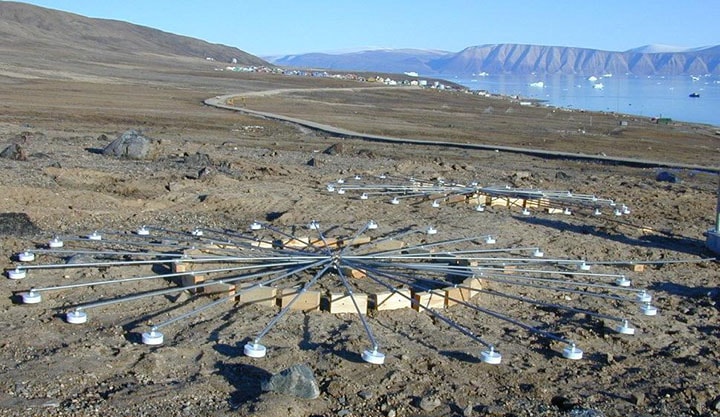
Once scientists have used computers to process the volcano’s infrasound, they identify what this indirect observation is “telling” them by making an inference. Inferring is when you use prior knowledge, past experience, and observations to explain what is happening. Inferring is what scientists do when explaining phenomenon.
Listen again to the infrasound from the Villarrica volcano chamber.
Remember that the scientists are focused on volcano sounds that are subaudible. With that in mind:
- How long do you think your straw would need to be in order to make a sound that you couldn’t actually hear, an infrasound?
- Think about the dimensions of the straw. Do you think just the length of the straw would matter? How about the width of the straw?
- How might you test your kazoo model?
If you think that the straw you would use would need to be really, really, really l-o-n-g and really, really, really w-i-d-e, you are correct. Remember that infrasound is something that humans cannot hear unaided because the sound has a very long wavelength and travels over a large distance.
- Listen again to the volcano’s sound, can you identify the changes in the sound Johnson is describing?
- Can you mimic the up and down pattern that the volcano’s sound makes with your kazoo? How does your breath model the position of the lava in the volcano’s chamber?
What Makes That Sound?

Sounds are all around—birds chirping, your favorite music, the clicking of a keyboard, burps. Sound is a wave that moves energy through a medium such as air or water.
Let’s see if we can match some sounds to their sources or what makes them.
Grab a piece of paper and a pencil! As you listen to the sounds in the chart below, make a hypothesis of what you think makes each sound. You may have heard sounds like the ones below before or perhaps not.
Remember that you are creating a hypothesis, so you need to identify both WHAT you think is making the sound and WHY you think that is. Be sure to think about anything in your experience that helped you identify the source of the sound. Try to use all the things you listen to such as music, movies, car noise, video games, or the outdoors as situations where you may have heard these sounds before.
You may need to listen to the sounds more than once. Try changing the volume so you can hear all the parts of the sound before you create your hypothesis.
- Sound One
- Sound Two
- Sound Three
- Sound Four
- Sound Five
- Sound Six
- Sound Seven
- Sound Eight
Scientists often use past experience and prior knowledge to make sense of their observations, which is called inferring.
- How did you use sounds that you have experienced before or ones that are familiar to you to identify these sounds?
- Ask a friend or a family member to listen to the sounds and compare your ideas.
Visualizing Waveforms
When you picture waves, you might recall waves in a pool or waves crashing on the shore. Waves in water and sound waves are both examples of mechanical waves, waves that are caused by vibrations or a disturbance in matter—solid, liquid, gas, or plasma. The matter that waves travel through is called a medium, for example waves in the ocean move through water.
Waves are represented by using waveform models.
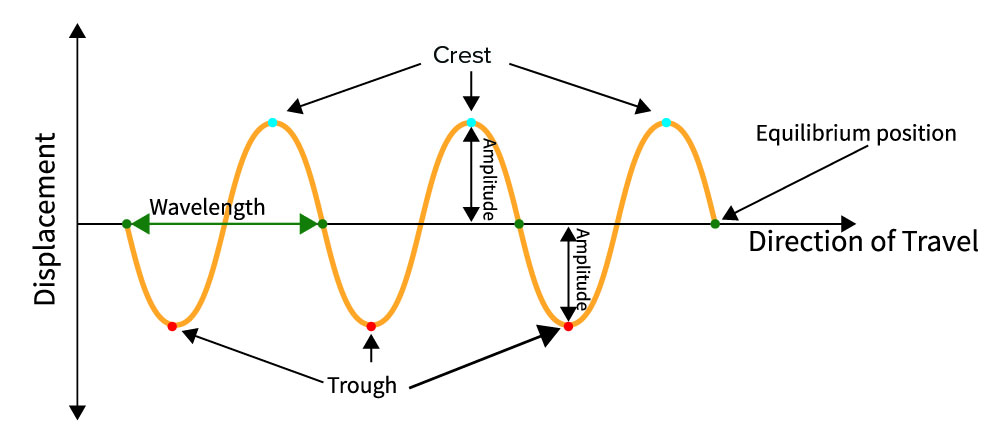
The shape of the waveform describes specific characteristics of that wave and the medium that the wave is moving through. For sound waves, the medium that energy travels through is air, or in some cases water, which is why you might be able to hear someone calling your name with your head underwater.
Waves have different wavelengths and frequencies. Wavelength measures the distance between two crests or two troughs of a wave. Waves have crests and troughs which are the highest point (crest) and the lowest point (trough.).
The amount the medium is moved away or displaced from its resting point is called the amplitude. The frequency of a wave is a time measurement that tells you how often a wavelength goes past a certain point.
Humans perceive amplitude as loudness, so if the sound is really loud, the waveform will show tall crests. These crests indicate the amplitude. If the sound has a high pitch, the waves will appear very close together. If the sound has a low pitch, the waves are wider apart.
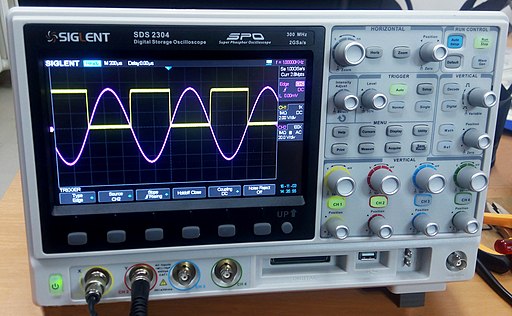
One tool that scientists use to analyze sound waveforms is an oscilloscope. Oscilloscopes translate wave energy into electrical pulses which are displayed as waveforms on the oscilloscope’s screen. Scientists and engineers use the shapes of the waves to identify features of the wave such as frequency and amplitude.
This is the waveform of a trombone slide shown on an oscilloscope.
|
|
|
Waveform And Oscilloscope Exploration
Grab a piece of paper and draw boxes or fold your paper so that you have eight rectangles to the page. Each box will represent an oscilloscope screen view of the waveform. Inside that box, draw a straight line horizontally across the middle. This will represent the medium’s rest position.

Go back to the list of sounds you listened to earlier and try to draw the sound wave crests and troughs so that it represents the loudness and pitch of the sound you hear.
For example, if you hear a long, slow, loud sound, the waveform drawing might look something like this:
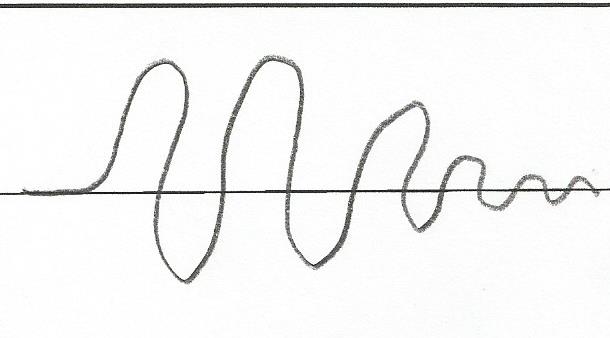
Can you tell where the louder and softer parts of the sound are by looking at the waveform?
- Is this a quiet sound or a loud sound or a mixture of both?
- Is this a deep sound or a high pitched sound? Can you explain your thinking?
If you thought that this sound is a loud, deep sound that slightly rises at the end, you are correct. You can listen to sound six above to compare the sound to the waveform.
Try drawing the waveform of your kazoo’s sound.
Are you able to capture how the sound of your kazoo changes with the rise and fall of the line away from the rest position? Did your kazoo waveform drawing look something like this?

How do you think the waveform model will be different if the length of the straw is short? Long?
Try drawing the waveform of the Villarrica volcano’s sound. Keep in mind what Johnson said about the volcano sounding like a musical instrument because of the resonance of the magma in the chamber. Are you able to demonstrate in your drawing how the volcano’s sound changes throughout the recording? Does your waveform drawing look something like this?
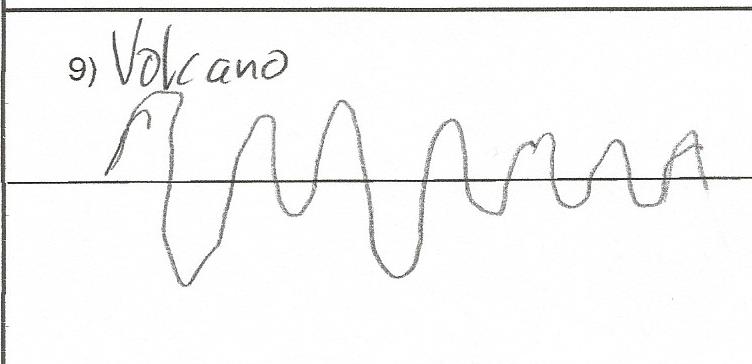
Let’s go back to the sounds we matched before. Based on your knowledge of crests, troughs, amplitude, pitch, and frequency, draw waveforms for each sound. Compare your waveform drawings to the image an oscilloscope would show. Open the Desmos Virtual Oscilloscope on an internet connected device. In order for the oscilloscope to work a mic must be installed/working and permitted in the browser window.
Use this online oscilloscope to spend time playing around until you are able to play the sound and view the oscilloscope screen at the same time.
For each waveform you drew:
- Compare your waveform waveform drawing to what you saw on the oscilloscope. How is it similar? Different?
- Does the general trend (overall pattern) of your waveform fit with the general trend as shown on the oscilloscope image?
- What do you think your kazoo’s waveform might look like on an oscilloscope?
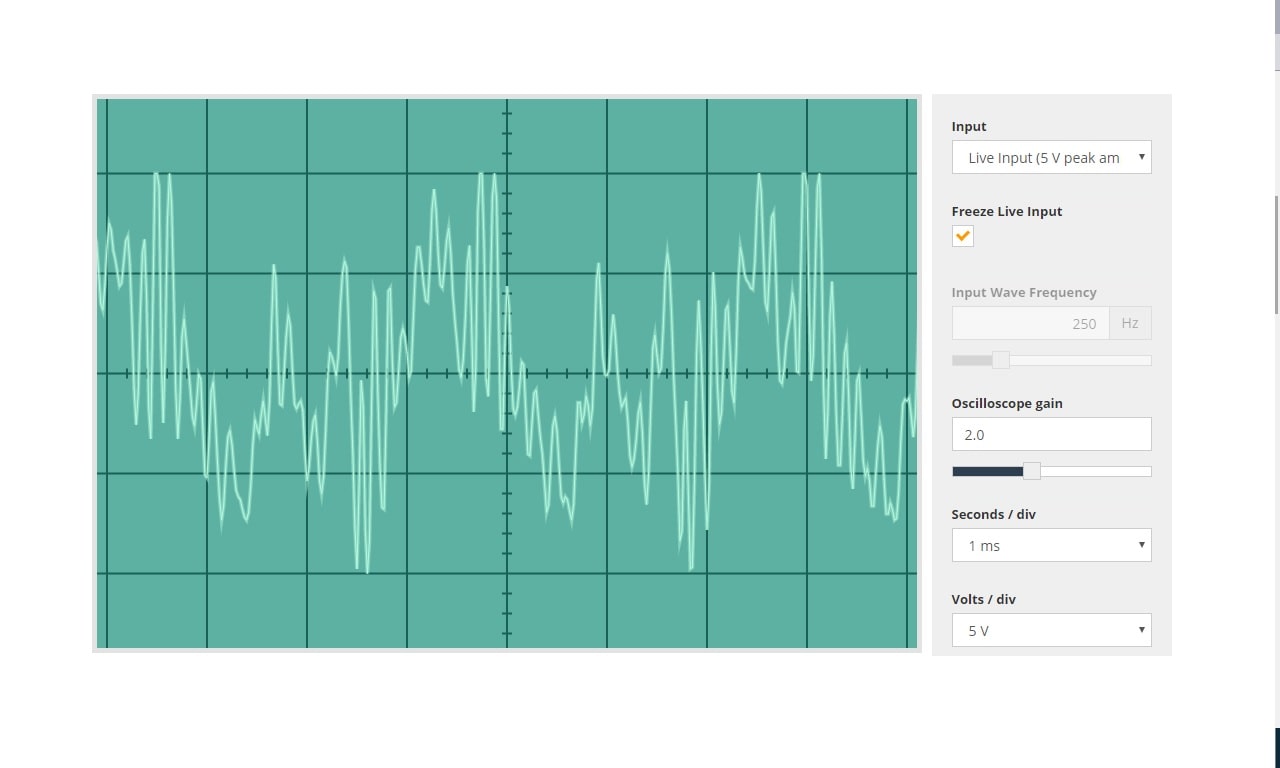
Think about how you drew your waveform to represent the Villarrica volcano. Johnson said that scientists can actually hear the sound change depending on the position of magma by identifying the change in the timbre—the pitch or intensity of the sounds and frequency of the sounds which suggests where the magma is deep in the volcano.
How does your waveform illustrate the changes in the sound?
Sound seven, the volcano’s sound might look something like this on the oscilloscope screen:

Sounding Like A Volcano
Now that you know what the infrasound of the Villarrica volcano sounds like and you can identify its waveform features, you can try recreating that sound as a Foley artist.
What is a Foley artist?
Foley artists are people who create and enhance sounds in the studio to add to a film. For instance, if you are watching a movie and a spaceship goes by onscreen you can hear the sound that the spaceship makes. However, in the real universe, would that traveling spaceship create a sound? No. Space is, in general, a vacuum, and sound would not travel. But we’re here on Earth and we are accustomed to things making noises as they go by. So, in order to make things feel more real to us, the Foley artist creates that sound or enhances it to make us feel that something is moving past us with mass, with size.
Even though the Villarica volcano’s infrasound that you heard was recorded over several days and was processed through computers to become audible, do you think you could recreate that sound or something close to it?
Try Your Hand At Being A Foley Artist
Can you create a sound to be used as a sound effect for a short video clip of the Villarrica volcano erupting?
Materials
- Three or four friends or family members to help operate the equipment and make more sound volume.
- All sorts of sound and noise-making tools such as cymbals or pan lids, wooden spoons, wooden blocks, handsaw, piece of plastic sheeting, garden hose pieces, bullroarers, and rain sticks.
- A room to work in as you will need to control the background sounds.
- The recordingof the Villarrica volcano infrasound and the video of the volcano erupting.
- A computer or mobile phone with video/audio capabilities.
- Look at your Villarrica volcano waveform drawing or oscilloscope image. These waveforms are models that you have created as guides to help you recreate the volcano’s sound.
- Test out your sound-making tools. In order to mimic the volcano’s sound, you may have to combine several of your sound-making tools all at once to make a fuller overall sound. Remember that you will need to have enough tools to make the various crests and troughs of the sound. Test out your tools so that you know which tools might make the different parts of the overall sound.
- Shape your Villarrica volcano sound. You may want to refer to your waveform models in order to practice re-creating the overall sound pattern and loudness. Practice making the sound for a longer time as well as a short time. Are there any of your tools that you don’t need? Is there something else that can add to the overall sound?
- Check your sound’s waveform. Once you become practiced at making the volcano sound, use the oscilloscope to check your sound’s waveform. Does the sound you made have enough crests and troughs to match either of the waveforms models of the Villarrica volcano (hand drawn or oscilloscope) that you created?
Reflect On Your Villarrica Volcano Sound
- What might you need to do with your sound-making tools to better match the sound you are making to your hand drawn or oscilloscope waveform models?
- What is the difference between the information you can use to better reproduce the sound between the two models you created?
- Can you identify the physical limitations that you are facing if you wanted to accurately reproduce the sound of the volcano?
- Record your sound to the video below using a screen recorder and post it to share!
Further Resources
- For more information on the Villarrica volcano, check out these pages from the Smithsonian and Oregon State University.
- Need some volcano basics? NASA has you covered with a brief volcano primer. Bonus, you can learn about volcanoes we’ve found in space!
- To learn about different volcanoes around the world, see Oregon State University’s Volcano Table.
- For live volcano monitoring, check out the maps and information on the Volcano Hazard website from the USGS.
Standards
Next Generation Science Standards
4-PS4 and MS-PS4: Waves and their Applications in Technologies for Information Transfer
- Disciplinary Core Idea: PS4.A – Wave Properties
- Science and Engineering Practice: Developing and Using Models
- Crosscutting Concepts: Patterns, Cause and Effect
Common Core State Standards
- Mathematics: MP.2 Reason abstractly and quantitatively.
- ELA/Literacy: WHST.6-8.9 Draw evidence from informational texts to support analysis, reflection, and research.
Special Thanks To: Chris Smith, Rob Cotton, and Dr. John S. Haywood.
Credits:
Written by Turtle Haste
Mentored by Jose Rivas
Review by Science Friday Educator Collaborative Cohort 6
Editing by Shirley Campbell, Xochitl Garcia, and Jose Rivas
Digital Production by Xochitl Garcia, Luke Groskin, and Ariel Zych
Header Image: The crater of Ecuador’s Cotopaxi volcano. Credit: Vargas/Insituto Geofisico of the Escuela Politecnica Nacional
Meet the Writer
About Turtle Haste
Turtle Haste is a science teacher at Desert Ridge Middle School in Albuquerque, New Mexico and the recipient of multiple Fulbright awards. She uses her passion for polar science, physical geography, and earth science to bring science to life for her 6th grade students.



